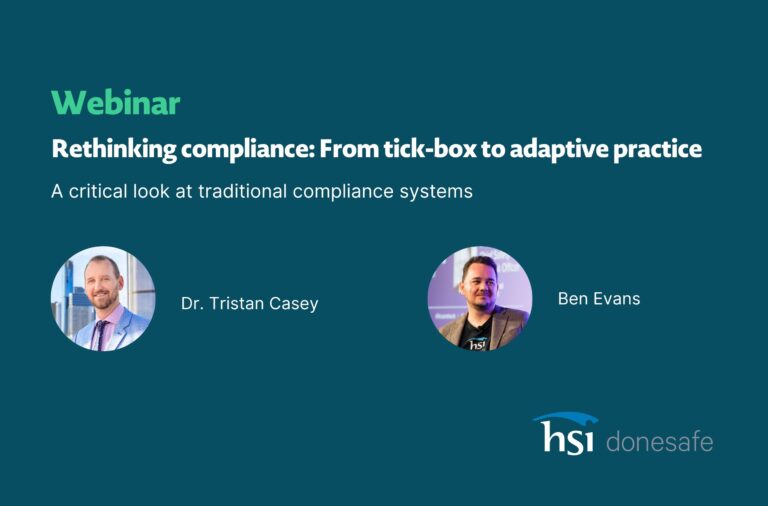
Keep people safe or face jail time of up to 25 years. The stakes, which are justifiably high, just got even higher.
New changes to WHS Laws make it even clearer for EHS professionals – if you’re negligent in providing a safe workplace you run the risk of heavy fines, reputational damage, closure of your organization and now personal criminal charges and time behind bars.
As of July 1, 2024, the Australian Commonwealth Work Health and Safety (WHS) Act introduced a new industrial manslaughter offense. This amendment, part of the Fair Work Legislation Amendment (Closing Loopholes) Act 2023, responds to community calls for stronger penalties for severe workplace safety breaches.
Key things to know about the changes
As outlined in the Industrial manslaughter and other work, health and safety reforms factsheet, the changes, that affect Persons Conducting a Business or Undertaking (PCBUs) and officers, will include the following:
Severe Penalties:
- Up to $18 million for corporations and 25 years’ imprisonment for individuals.
- Significant increases to the Category 1 offense penalties from $3 million to $15 million for a body corporate, from $600,000 to $3 million for a person conducting a business or undertaking or an officer, and from $300,000 to $1.5 million for any other person.
- A 39.03% increase to all other penalties in the WHS Act.
- For those penalties which have increased, an indexing mechanism to annually increase penalties in line with the national consumer price index.
- New criminal responsibility provisions for bodies corporate and the Commonwealth.
Prosecution Criteria:
- Requires proof of negligence or recklessness and intentional conduct.
No Limitation Period: Proceedings can be initiated at any time.
The banning of Enforceable Undertakings (EUs): EUs cannot be considered in industrial manslaughter cases.
As stated on Comcare’s update page:
“New criminal responsibility provisions promote accountability for bodies corporate and the Commonwealth for breaches of work health and safety duties. The changes mean that the conduct of officers, employees and agents acting within their actual or apparent authority (defined as ‘authorised persons’), and/or the board of directors for a body corporate, can be attributed to a body corporate.”
What Will These Changes Mean?
The changes being implemented will lead to even safer workplaces and allow continuous feedback from those directly or indirectly affected by a serious injury, illness or death. Broadly, the changes will ensure:
- Promotion of Compliance: The industrial manslaughter offense and higher penalties for breaching work health and safety duties will promote compliance and help make workplaces safer.
- Addressing Community Concerns: The offense will apply higher penalties to the most egregious breaches of work health and safety duties, particularly those causing death.
- Maintaining Penalty Value: The indexing mechanism will ensure WHS penalties retain their relative value and remain a serious deterrent into the future.
- Accountability for Breaches: New criminal responsibility provisions will ensure bodies corporate and the Commonwealth are held accountable for breaches of work health and safety duties.
How can you and your organization reduce the risk of negligence?
To mitigate risks of negligence and comply with these stringent laws, organizations should adopt safety best practices. Compliance with all regulatory requirements is critical and you should have systems in place that keep you up-to-date and maintain compliance across the organization.
- Up-to-Date Software: Leveraging advanced safety management software ensures real-time monitoring, data collection, and analysis. This helps in identifying potential hazards and responding to them before they lead to serious incidents.
- Unified Systems: Integrated systems that combine EHS (Environmental Health and Safety) and injury management provide an holistic view of workplace safety. Unified reporting and communication streamline safety processes and ensure comprehensive incident tracking and response.
- Holistic Approach to EHS: An holistic approach involves continuous risk assessments, proactive hazard identification, and comprehensive training programs. It also emphasizes employee involvement in safety initiatives, fostering a culture of safety across the organization. Your systems should be easy to use and encourage adoption and engagement.
Going deeper, your EHS system should adapt to your organization and provide coverage across all aspects of safety. For example, some of Donesafe’s modules are listed below.
| Compliance Requirement | HSI Donesafe Feature/Capability | Description |
| Incident Reporting and Investigation | Incident Management Module | Allows detailed reporting and investigation of incidents, ensuring all workplace deaths are thoroughly documented. |
| Risk Management | Risk Management Module | Identifies, assesses, and mitigates risks to prevent incidents leading to industrial manslaughter. |
| Compliance Management | Compliance Obligations Module | Tracks and manages compliance across different states and territories. |
| Training and Education | Training Management Module | Ensures all employees and senior officers are trained on EHS regulations and legislation. |
| Audit Management | Audit Management Module | Facilitates regular audits to ensure compliance with EHS regulations and identify areas for improvement. |
| Hazard Identification and Risk Assessment (HIRA) | Hazard and Risk Assessment Tools | Systematically identifies and assesses workplace hazards to prevent incidents. |
| Document Management | Document Management Module | Maintains all necessary documentation, including safety procedures, training records, and compliance reports. |
| Real-time Reporting and Analytics | Advanced Reporting and Analytics | Provides real-time insights and analytics to monitor compliance and identify potential risks before they lead to incidents. |
| Corrective and Preventive Actions (CAPA) | CAPA Module | Tracks and manages corrective and preventive actions to address identified risks and prevent recurrence of incidents. |
| Incident Root Cause Analysis | Root Cause Analysis Tools | Helps in conducting thorough root cause analysis to understand underlying factors of incidents and prevent future occurrences. |
| Legal Compliance Monitoring | Legal Compliance Tools | Monitors and updates compliance status with current legislation. |
| Employee Health and Safety Programs | Health and Safety Programs | Implements programs to ensure a safe working environment and promote employee well-being. |
| Centralized Data Management | Centralized EHS Data Management | Centralizes all EHS data for easy access, tracking, and reporting, ensuring comprehensive compliance oversight. |
Rather than operating as separate and siloed systems, Donesafe’s modules work seamlessly together and integrate with other 3rd party systems. This gives you a 360-degree view of your safety risks which in turn gives you the insights you need to maintain the safest working environment.
Changes to legislation, such as the recent industrial manslaughter laws, underscores the importance of robust safety practices and accountability in the workplace. By adopting up-to-date software, unified systems, and an holistic approach to EHS, organizations can significantly reduce the risks of negligence and ensure compliance, creating a safer workplace today and into the future.
Want help to get your EHS systems to full coverage? Get in touch and one of our experts can guide you through the modules you need based on your specific needs.
Want to ensure your workplace is compliant? Reach out today.
Share:



